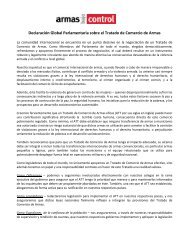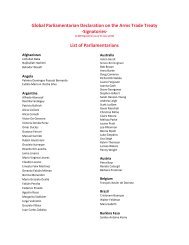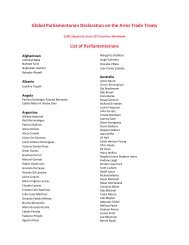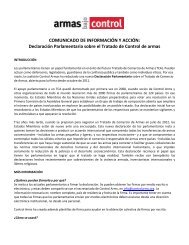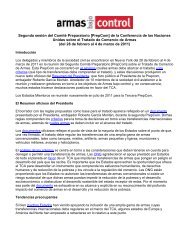Making it Work - Control Arms
Making it Work - Control Arms
Making it Work - Control Arms
- No tags were found...
You also want an ePaper? Increase the reach of your titles
YUMPU automatically turns print PDFs into web optimized ePapers that Google loves.
SAFERWORLD 23emissions target. The Enforcement Branch of the Compliance Comm<strong>it</strong>tee determinescases of parties’ compliance w<strong>it</strong>h emissions targets, mon<strong>it</strong>oring and reporting requirementsand eligibil<strong>it</strong>y to participate in the emissions trading mechanisms. TheComm<strong>it</strong>tee’s procedures are triggered when <strong>it</strong> receives ‘questions of implementation’,e<strong>it</strong>her in reports by the ERTs, or from a party w<strong>it</strong>h respect to <strong>it</strong>self or from any partyw<strong>it</strong>h respect to another party, as long as <strong>it</strong> has corroborating information.Under CITES the Secretariat can conduct missions to parties undergoing implementationproblems in order to collate relevant information, evaluate problems and provideadvice to relevant author<strong>it</strong>ies. Secretariat missions are also used to assess progresswhere implementing cond<strong>it</strong>ions have been set down w<strong>it</strong>h regard to the lifting of tradesanctions. Missions are only conducted w<strong>it</strong>h the approval of the state party concerned.Another type of mission involving technical experts, organised by the Secretariat andthe Standing Comm<strong>it</strong>tee, has frequently been tasked w<strong>it</strong>h investigating problems concerningthe illegal trade in endangered species, particularly rhinos and tigers. Thesehave been followed by high-level pol<strong>it</strong>ical delegations that report their conclusions tothe Standing Comm<strong>it</strong>tee and the CoP. 33ConclusionThe establishment of some form of verification measures under an ATT could play animportant part in efforts to build confidence in the effectiveness of the regime and topromote full compliance. Indeed, to this end, a number of states responding to the UNSecretary General called for the establishment of a mechanism for overseeing ATTcompliance. 34While representing a substantial comm<strong>it</strong>ment by states parties, provisions for incountrymon<strong>it</strong>oring and verification can help build confidence in the effective implementationof a treaty. Indeed, the experience of the CWC indicates that if suchprovisions are used early on w<strong>it</strong>hin the lifetime of a treaty regime, and are targetedtowards resolving low-level compliance issues, then the mechanism in question ismore likely to function effectively thereafter. Confidence is increased where there arereview mechanisms that include a capac<strong>it</strong>y-building function to help parties improvetheir mon<strong>it</strong>oring and reporting procedures, as is the case under the UNFCCC/KyotoProtocol review process.While mon<strong>it</strong>oring and verification mechanisms are typically not implemented to theoptimal extent, experience under the CFE Treaty, the CWC, CITES and the UNFCCC/Kyoto Protocol suggests that such mechanisms are a valuable tool, especially as part ofa package of compliance measures. Thus, the establishment of regular mon<strong>it</strong>oringefforts under an ATT could contribute to the development of an effective regime andcould conceivably include verification activ<strong>it</strong>ies. To enhance accountabil<strong>it</strong>y in theinternational arms transfer chain, these mon<strong>it</strong>oring and verification measures couldapply not only to arms exporting and importing states but also to trans<strong>it</strong> and transhipmentstates, as well as those providing a base for the operation of international armsbrokers. Such measures could include, for example, inspections of transfer licensingrecords and of procedures and records kept at ex<strong>it</strong> and entry points for armsshipments. In add<strong>it</strong>ion to assisting in the detection of compliance problems, suchprovisions could be useful in highlighting cases whereby, for example, data retrieval,management and storage or a lack of capac<strong>it</strong>y, resources or relevant expertise arepreventing states from fulfilling their obligations under the Treaty. W<strong>it</strong>h such informationto hand co-operative efforts could be undertaken and assistance provided so as toresolve such matters.33 Rosalind Reeve, Ibid. According to Rosalind Reeve, technical missions – the compos<strong>it</strong>ion of which is decided by the chair ofthe Standing Comm<strong>it</strong>tee – typically consist of one or more Secretariat staff, accompanied by experts drawn from the IUCNand TRAFFIC. Accompanied by representatives of the host government, they examine records, conduct interviews and vis<strong>it</strong>relevant s<strong>it</strong>es.34 The Global <strong>Arms</strong> Trade Treaty: What States Want, Ibid p 37 and Analysis of States’ Views on an <strong>Arms</strong> Trade Treaty, pp 11–12.



